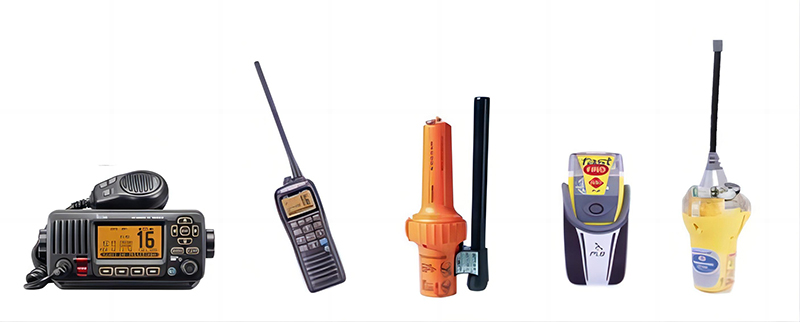
How to equip your ship with a reasonable set of marine communication equipment
Overview
SOLAS categorizes marine communication equipment in terms of functionality
1. Alarms:
Sending distress alarms from ship to shore
Sending distress alarms from shore to ship
Sending distress alarms from ship to receiving ship
2. Communication:
Sending and receiving search and rescue coordination information
Sending and receiving on-site message
Sending and receiving general radio information to shore-based systems
Communication between pilot cabin to pilot cabin
3. Radar transponder:
Receiving and transmitting positioning signals of radar transponders at 9GHz
4. MSI:
Receiving and transmitting maritime safety information
The distance between ship and shore based communication station is an important factor in determining the configuration of marine communication equipment. The International Maritime Organization(IMO) stipulates that different sea areas have different requirements for the configuration of ship communication equipment, including general requirements and additional requirements.
The 4 types of sea areas
A1: Coastal sea area. It is an area where at least one very high-frequency coast station's radio telephone coverage can extend and continuous digital selective calling (DSC) is effective. Typically, this area extends from the coast to 30-50 nautical miles.
A2: It is an area where at least one medium-frequency coast station's radio telephone coverage can extend and continuous DSC is effective. Typically, this area extends from the coast to 50-150 nautical miles.
A3: An area covered by a recognized mobile satellite service Ship Earth Station with continuous distress alerting capability supported by shipborne mobile earth stations, excluding A1 and A2 sea areas. Generally, this area is between 70 degrees north latitude and 70 degrees south latitude.
A4: It refers to sea areas other than A1, A2, and A3 sea areas. This area is basically polar, i.e., areas above 70 degrees north latitude and below 70 degrees south latitude.
SOLAS's general requirements for the configuration of ship communication equipment in A1, A2, A3, and A4 sea areas
1. VHF radio equipment:
Includes Digital Selective Calling (DSC) function.
Capable of multi-channel wireless communication.
Has 70-channel DSC Watch Receiver.
Capable of sending DSC alarms, receiving alarms on watch, and for wireless telephone communication.
2. 9GHz radar transponder: Capable of receiving and transmitting positioning signals of 9GHz radar transponders.
3. NAVTEX navigational warning broadcast receiver: Capable of receiving maritime safety information within approximately 400 nautical miles offshore.
4. INMARSAT MSI receiving equipment: Capable of receiving MSI from INMARSAT, including MSI beyond the coverage range.
5. EPIRB (Emergency Position Indicating Radio Beacon): Sends alerts via the 406MHz channel through polar orbiting satellites.
6. Two-way VHF radiotelephone apparatus.

SOLAS's additional requirements for marine communication equipment in A1, A2, A3, and A4 sea areas
Marine Communication Device | A1 | A2 | A3 | A4 | ||
INMARSAT | MF/HF | |||||
VHF | VHF DSC | √ | √ | √ | √ | √ |
VHF DSC WR | √ | √ | √ | √ | √ | |
VHF radiotelephone | √ | √ | √ | √ | √ | |
MF | MF DSC | √ | √ | √ | √ | |
MF DSC WR | √ | √ | √ | √ | ||
MF radiotelephone | √ | √ | √ | √ | ||
NBDP | √ | √ | ||||
HF | HF DSC | √ | √ | |||
HF DSC WR | √ | √ | ||||
HF radiotelephone | √ | √ | ||||
NBDP | √ | √ | ||||
INMARSAT direct printing | √ | |||||
In addition to the above standard configuration (general requirements + special requirements), the IMO has also proposed Maintenance Requirements, which include three methods: a. Shore-based maintenance; b. Onboard maintenance; c. Dual redundancy configuration.
1. Shore-based maintenance: Regularly sending equipment to shore-based companies for maintenance.
2. At-sea maintenance capability: Crew members holding a "First or Second Class Radiotelegraph Operator" certificate are qualified to perform maintenance at sea.
3. Duplication of equipment: Some communication equipment requires two units for replacement purposes.
According to SOLAS requirements, A1 and A2 sea areas only require one of the three maintenance methods, while A3 and A4 must have two methods. Typically, there are few certified radio operators onboard, so the mainstream equipment is shore-based maintenance + duplication of equipment, as shown in the table below:
Sea area | Duplicated equipment |
A1 | A VHF radio installation |
A1+A2 | A VHF radio installation An MF radio installation |
A1+A2+A3 (INMARSAT option) | A VHF radio installation An Inmarsat SES OR MF/HF with telephony, DSC and Direct Printing Telegraphy |
A1+A2+A3 (HF option) | A VHF radio installation An Inmarsat SES OR MF/HF with telephony, DSC and Direct Printing Telegraphy |
A1+A2+A3+A4 | A VHF radio installation MF/HF with telephony,DSC and Direct Printing Telegraphy |
Now, you can check your ship's communication equipment based on the above. We provide comprehensive and high-quality communication equipment for you to purchase at any time.





